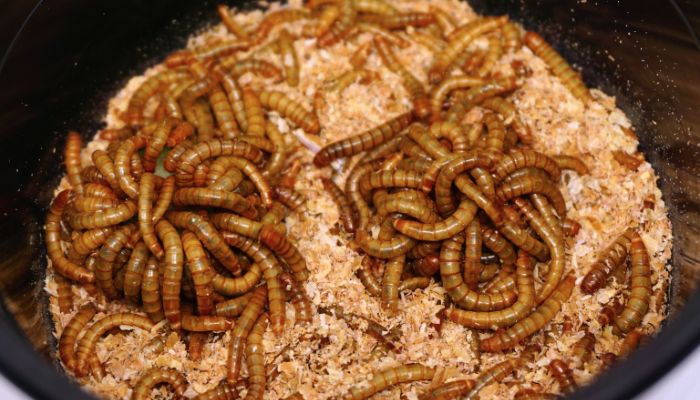Garter snakes, with their vibrant patterns and curious nature, have always intrigued reptile enthusiasts. But what do these slithery creatures munch on, especially when they’re just tiny babies?
Baby garter snakes primarily consume small fish, earthworms, and tiny amphibians. In captivity, they often feast on fish like minnows and guppies, as well as earthworms. In the wild, their diet can also include insects, small reptiles, and occasionally eggs from various sources.
Dive into this comprehensive guide to uncover the dietary habits of baby garter snakes, from their favorite foods to their unique hunting techniques. We’ve also tackled some frequently asked questions and highlighted essential dos and don’ts.
Whether you’re a seasoned snake keeper or just snake-curious, this article promises a deep dive into the fascinating world of garter snake gastronomy.
Let’s start!

Table of Contents
- 1 Dietary Habits of Garter Snakes
- 2 List of Foods Commonly Consumed by Garter Snakes
- 2.1 Small invertebrates: Earthworms and slugs.
- 2.2 Amphibians: Frogs, toads, salamanders, and newts.
- 2.3 Insects: Crickets and grasshoppers.
- 2.4 Reptiles: Lizards and smaller snakes.
- 2.5 Birds: Especially smaller species.
- 2.6 Fish: Minnows and guppies.
- 2.7 Mammals: Mice, shrews, and chipmunks.
- 2.8 Others: Snails and eggs (from birds, reptiles, or fish).
- 3 Hunting Techniques of Garter Snakes
- 4 Foods to Avoid
- 5 How Much and How Often to Feed
- 6 Final Word
- 7 FAQ
Dietary Habits of Garter Snakes
When it comes to baby garter snakes, their dietary habits are a tad different and quite intriguing. Let’s dive into the world of these slithery creatures and uncover the mysteries of their diet.
What do baby garter snakes eat in captivity?
In the wild, these little guys are opportunistic feeders, munching on whatever they can get their tiny jaws around. But in captivity, their diet becomes a bit more refined.
Typically, baby garter snakes in captivity feast on a menu of small fish, earthworms, and occasionally, tiny amphibians. Think of it as their version of a three-course meal.
The fish serves as the main course, earthworms as the side dish, and if they’re feeling adventurous, a little frog or toad for dessert. Yum!
Garter snakes as strict carnivores.
Now, before you start thinking about offering your baby garter snake a nice salad or some fruit, hold that thought! Garter snakes are strict carnivores. This means they only eat meat. No veggies, no fruits, just pure, unadulterated protein. It’s like they’re on a permanent keto diet!
Their carnivorous nature is deeply rooted in their biology. Their digestive systems are designed to break down and extract nutrients from animal matter. So, while that lettuce might look tempting, it’s not going to do your garter snake any good.
Their preference for live prey.
One fascinating aspect of garter snakes, especially the babies, is their preference for live prey. It’s not just about the nutrition; it’s about the thrill of the hunt! In the wild, these snakes rely on their keen senses to detect and capture moving prey.
This instinct doesn’t just disappear in captivity.
Offering them live prey, like wriggling earthworms or swimming fish, stimulates their natural hunting instincts. It’s like watching a nature documentary in real-time, right in your living room. However, always ensure the prey is safe and free from potential diseases.
Their occasional consumption of eggs for protein.
Now, here’s a fun fact: while it’s not a staple in their diet, garter snakes have been known to occasionally snack on eggs. Yes, eggs! These protein-packed treats can be a delightful change of pace for your snake.
But remember, we’re talking about small eggs here, like those of tiny birds or amphibians.
Eggs offer a different kind of protein and nutrients that can be beneficial for garter snakes, especially when they’re growing. But like all good things, moderation is key. It’s more of an occasional treat rather than a regular menu item.

List of Foods Commonly Consumed by Garter Snakes
From the tiniest of invertebrates to the occasional mammal, these snakes have a taste for it all. Let’s embark on a culinary journey and explore the extensive menu of the garter snake.
Small invertebrates: Earthworms and slugs.
Starting with the basics, earthworms and slugs are like the bread and butter of a garter snake’s diet. Easy to find and packed with nutrients, these invertebrates are a staple, especially for the younger snakes.
Imagine slurping up a juicy earthworm or a tender slug—it’s like a spaghetti dinner for them!
Amphibians: Frogs, toads, salamanders, and newts.
Now, this is where things get interesting. Garter snakes have a particular fondness for amphibians. Frogs and toads, with their soft bodies, are a delightful treat. Salamanders and newts, on the other hand, offer a unique flavor profile.
It’s like choosing between chicken and beef for us. Each amphibian brings something different to the table, and garter snakes are here for it all.
Insects: Crickets and grasshoppers.
While not the main course, insects like crickets and grasshoppers are the perfect snack for garter snakes. Think of them as the chips and dip of the snake world. Crunchy on the outside and soft on the inside, these insects provide a quick energy boost.
Plus, the way they jump and move adds a fun challenge to the hunting game.
Reptiles: Lizards and smaller snakes.
Yes, you read that right. Garter snakes aren’t above dining on their fellow reptiles. Lizards, with their scaly bodies and swift movements, are a delicacy.
And smaller snakes? Well, it’s a snake-eat-snake world out there. It might sound a bit cannibalistic, but in the wild, it’s all about survival.
Birds: Especially smaller species.
Birds might not be the first thing that comes to mind when you think of snake food, but garter snakes aren’t picky. Smaller bird species, especially the young ones, are fair game. It’s a rare treat, but when the opportunity presents itself, garter snakes are quick to seize it.
Fish: Minnows and guppies.
Taking a dive into the aquatic realm, garter snakes have been known to enjoy a fishy feast. Minnows and guppies are the preferred choices. These small fish are easy to catch and offer a different texture and taste. It’s like having sushi, fresh from the source!
Mammals: Mice, shrews, and chipmunks.
Moving up the food chain, garter snakes occasionally indulge in mammals. Mice and shrews are the more common choices, but a daring garter snake might even take on a chipmunk. It’s a high-risk, high-reward situation.
These mammals are packed with nutrients, making them a valuable meal.
Others: Snails and eggs (from birds, reptiles, or fish).
Last but not least, we have the oddballs of the garter snake diet. Snails, with their crunchy shells and soft insides, are a unique treat. And eggs? Well, they’re like nature’s protein shake.
Whether they come from birds, reptiles, or fish, eggs are a nutritious and delicious choice.

Hunting Techniques of Garter Snakes
Their techniques are a blend of patience, precision, and innate instincts. Let’s delve into the world of garter snake hunting and uncover the secrets behind their success.
Description of their ambush strategy.
Garter snakes are all about the element of surprise. They employ an ambush strategy, where they lie in wait, camouflaged in their surroundings, patiently waiting for unsuspecting prey to come close.
And when the moment is just right—BAM!—they strike with lightning speed. It’s like a well-executed jump scare in a horror movie, but in the wild.
Explanation of their keen senses, especially sight and smell.
While their ambush strategy is impressive, it’s their keen senses that truly set them apart. Garter snakes have sharp eyesight, allowing them to detect even the slightest movement. But it’s their sense of smell that’s the real game-changer.
They use their forked tongues to pick up scent particles from the air, giving them a detailed olfactory map of their surroundings.
Role of the vomeronasal organ in detecting prey.
Now, here’s where things get science-y. Garter snakes have a special organ called the vomeronasal organ. Located in the roof of their mouth, this organ processes the scent particles collected by their tongues.
It’s like having a built-in GPS system that guides them straight to their prey.
Mention of their weak neurotoxic venom.
While garter snakes are generally harmless to humans, they do possess a weak neurotoxic venom. This venom is primarily used to immobilize their prey, making the hunt a tad easier. It’s not potent enough to harm larger animals, but for small prey, it’s a game-changer.

Foods to Avoid
Now, while garter snakes have a diverse diet, there are certain foods that are a big no-no. It’s essential to know what to avoid to ensure the health and well-being of these slithery creatures.
Why certain foods, like crickets and mealworms, aren’t suitable.
Crickets and mealworms might seem like a good idea, but they’re not the best choice for garter snakes. These insects have a hard exoskeleton, which can be difficult for garter snakes to digest. It’s like trying to eat a candy with a super tough wrapper—just not worth the effort.
The dangers of feeding wild-caught amphibians and reptiles.
Wild-caught amphibians and reptiles might seem like a fresh and natural choice, but they come with risks. These animals can carry parasites or diseases that can harm garter snakes. It’s like eating street food in a foreign country—delicious, but potentially risky.
Always ensure that the food you offer is safe and free from potential threats.

How Much and How Often to Feed
Feeding a garter snake is not just about what you feed them, but also how much and how often. You wouldn’t want to overeat or starve, and the same goes for these slithery friends. Let’s dive into the nitty-gritty of feeding frequencies and quantities.
The difference in feeding frequency based on food type.
Different foods have different nutritional values, and this plays a significant role in determining how often you should feed your garter snake. For instance:
- Fish and Earthworms: These can be fed more frequently, say every 2-3 days, as they are easily digestible and provide essential nutrients.
- Mammals like Mice: These are richer in nutrients and can be fed less often, perhaps once a week or every ten days.
- Amphibians and Reptiles: Depending on their size, these can be offered every 5-7 days.
It’s all about balance. Think of it as having a salad versus a steak dinner. One might fill you up quickly, but the other keeps you full for longer.
Signs that you might be overfeeding or underfeeding.
Just like us, garter snakes give signs when their diet isn’t quite right. Here are some things to watch out for:
- Overfeeding: If your snake becomes lethargic, has difficulty moving, or shows signs of rapid weight gain, you might be offering too much food. It’s like feeling stuffed after a big holiday meal.
- Underfeeding: On the flip side, if your snake becomes overly active, constantly searching for food, or shows signs of weight loss, it might be time to up the portions or feed more frequently.
Final Word
Understanding their dietary needs is crucial, whether you’re a snake enthusiast or a curious learner.
Remember, a well-informed approach ensures the well-being of these fascinating creatures. Keep nurturing your curiosity and continue exploring the wonders of the natural world.
Your dedication to learning is commendable, and every bit of knowledge empowers you further. Keep it up!
FAQ
When it comes to baby garter snakes, there are always a few queries that pop up more often than others. Let’s tackle some of the most common ones.
How often do you feed a baby garter snake?
Baby garter snakes have a faster metabolism, so they need to eat more frequently. Depending on the type of food, you should feed them every 2-5 days. Remember, it’s all about providing them with the right nutrients to support their growth.
Why won’t my baby garter snake eat?
There could be several reasons. Stress, a new environment, or even the type of food offered can affect their appetite. Ensure the environment is stress-free, try different foods, and be patient. Sometimes, they just need a little time to adjust.
How do you pick up a baby garter snake?
Gently and with care! Use a soft touch, approaching the snake from the side rather than from above. Avoid sudden movements and ensure your hands are warm. Remember, they’re delicate creatures, so always handle with love and caution.




0 Comments